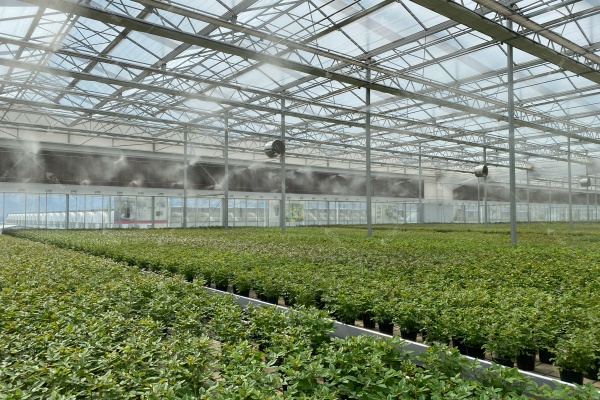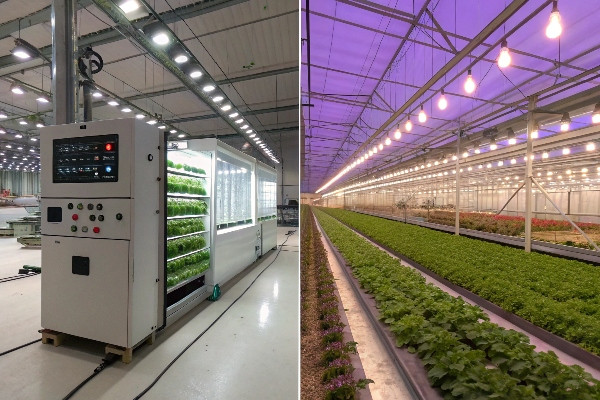When winter temperatures drop below freezing, your crops face a battle for survival. Traditional greenhouses struggle to maintain warmth, leading to failed harvests and lost profits.
A deep winter greenhouse combines advanced insulation systems with passive solar heating to maintain optimal growing conditions year-round. These structures use thermal mass, reflective surfaces, and strategic orientation to capture and store solar energy while minimizing heat loss through specialized covering materials.
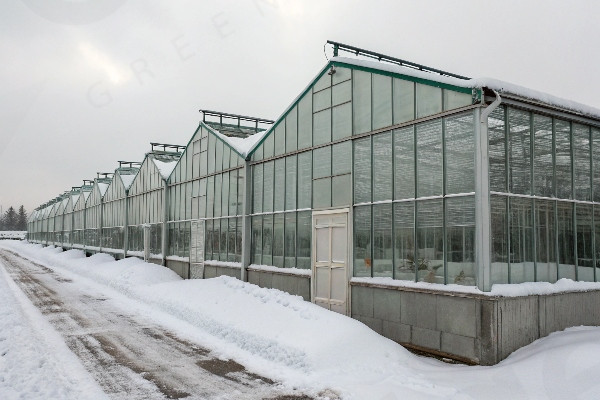
After 29 years of designing greenhouse solutions for extreme climates, I have seen countless growers transform their winter operations with proper deep winter greenhouse technology. The difference between success and failure often comes down to understanding how these systems work and implementing the right combination of features for your specific climate zone.
Don’t Miss:——Commercial Hydroponic Greenhouse Systems: How Do Design, Construction, and ROI Interconnect?
You might like:——What is a Smart Greenhouse? The Ultimate Guide to Automated Growing
What are the Design Features of a Deep Winter Greenhouse?
Your greenhouse structure becomes your first line of defense against harsh winter conditions. Every design element must work together to create a thermal envelope that protects your crops.
Deep winter greenhouses feature double or triple-wall glazing, thermal curtains, buried foundations, and strategic ventilation systems. These components create multiple barriers against heat loss while allowing maximum light penetration during short winter days.
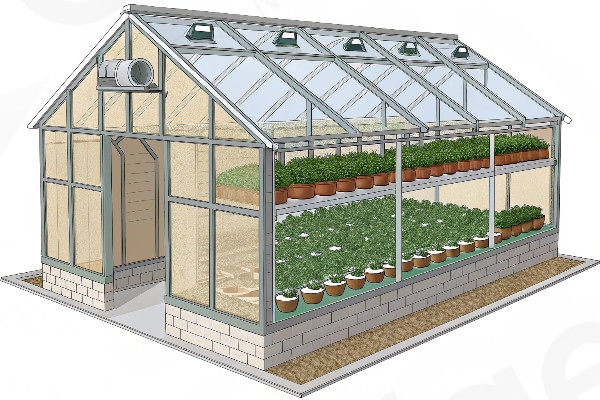
The foundation system extends below the frost line to prevent ground heat loss and provide thermal stability. In our projects across Central Asia, we typically recommend foundations that go at least 4 feet deep, depending on local frost depth requirements. The north wall often features insulated panels rather than transparent glazing to reduce heat loss from the direction that receives no direct sunlight.
Structural Components for Winter Performance
The glazing system forms the heart of thermal performance in deep winter applications. We use multi-wall polycarbonate panels that provide excellent insulation while maintaining light transmission rates above 80%. These panels create air pockets that act as thermal barriers, significantly reducing heat transfer compared to single-layer materials.
Thermal curtain systems represent another critical design feature that I always recommend to clients in cold regions. These automated curtains deploy during nighttime hours to create an additional insulation layer between the growing space and the glazing. The curtain material typically consists of reflective aluminum strips combined with thermal fabric that can reduce heat loss by up to 50% during winter nights.
The roof pitch and orientation require careful calculation based on your latitude and local sun angles. We design our deep winter structures with steeper roof angles than standard greenhouses to maximize solar gain during winter months when the sun sits lower in the sky. This geometric optimization can increase winter solar collection by 15-20% compared to standard greenhouse designs.
How Do Deep Winter Greenhouses Use Passive Solar Heating?
Solar energy becomes your most valuable resource during winter months when heating costs typically spike. Smart greenhouse design captures and concentrates this free energy source throughout the daylight hours.
Passive solar heating relies on south-facing orientation, thermal mass placement, and reflective surfaces to collect, store, and distribute solar energy. This system reduces heating costs by 40-60% compared to conventional heated greenhouses.
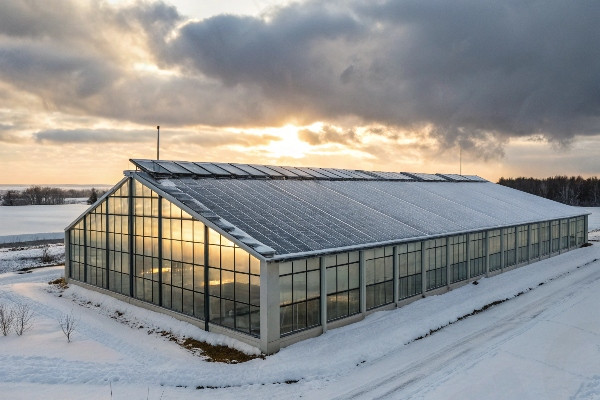
The greenhouse orientation becomes absolutely critical for passive solar performance1. We position the long axis running east to west, with the primary glazed surface facing true south. This configuration maximizes solar exposure during winter months when every BTU of free energy counts toward your heating bill.
Solar Collection and Distribution Methods
Reflective materials integrated into the north wall and floor systems amplify the available solar energy within the growing space. We install white or aluminum-coated surfaces that redirect sunlight onto plants and thermal mass elements. This technique can increase the effective solar radiation by 25-30% without adding any external energy inputs.
The glazing angle and seasonal adjustability affect year-round performance in deep winter applications. Some of our advanced designs incorporate adjustable panels that can be repositioned throughout the winter season to maintain optimal sun angles as the solar path changes. While this adds complexity to the system, the energy gains often justify the additional investment for commercial operations.
Air circulation patterns distribute the collected solar heat throughout the growing space using natural convection currents. We design ventilation systems that create gentle air movement during sunny winter days, moving warm air from collection zones to plant growing areas. This passive distribution system eliminates the need for fans and reduces electrical consumption while maintaining uniform temperatures.
Glazing selection impacts both solar collection and heat retention in deep winter conditions. We typically recommend low-iron glass or specialized polycarbonate materials that maximize light transmission while providing adequate insulation values. The balance between these two factors determines the overall thermal performance of your passive solar system.
What Heat Storage Techniques are Common in Deep Winter Greenhouses?
Storing thermal energy during sunny periods allows your greenhouse to maintain warmth through cold nights and cloudy weather. The thermal mass system2 acts like a battery for solar energy.
Common heat storage techniques include water barrels, concrete floors, rock beds, and phase-change materials. These systems absorb excess heat during day hours and release stored energy slowly throughout the night to maintain stable temperatures.

Water represents the most cost-effective thermal mass option for most deep winter greenhouse applications. We typically install 55-gallon barrels painted black and positioned along the north wall where they receive maximum solar exposure. Each barrel can store approximately 23,000 BTUs per degree of temperature rise, providing substantial thermal buffering capacity.
Advanced Thermal Storage Technologies
Concrete floors create distributed thermal mass throughout the entire growing area while serving the practical function of providing stable walkways and equipment foundations. We pour concrete slabs at least 4 inches thick with embedded tubing for optional radiant heating systems. The concrete absorbs solar energy during the day and radiates heat back to plants during nighttime hours.
Rock bed thermal storage systems offer excellent heat capacity while providing natural humidity regulation for the growing environment. We install these systems beneath the greenhouse floor, using 2-4 inch diameter stones with air circulation channels. The rock bed connects to the greenhouse through ducted fans that circulate warm air during collection periods and draw stored heat during release cycles.
Phase-change materials represent the cutting edge of thermal storage technology for greenhouse applications. These specialized wax-based compounds can store 5-10 times more energy per pound than traditional thermal mass materials. While the initial cost runs higher than conventional options, the space efficiency and performance benefits often justify the investment for high-value crop production.
Underground thermal storage extends the heat storage capacity beyond what above-ground systems can provide. We excavate storage chambers beneath the greenhouse and fill them with water, rocks, or specialized thermal storage media. These systems maintain more stable temperatures year-round and can store enough energy to carry the greenhouse through extended cloudy periods.
Which Regions and Crops are Suitable for Deep Winter Greenhouses?
Geographic location and crop selection determine the success of your deep winter greenhouse operation. Some regions and plants naturally align with this growing method while others require additional considerations.
Deep winter greenhouses work best in USDA zones 3-7 with crops like leafy greens, herbs, root vegetables, and cold-hardy flowers. Northern regions benefit most from the solar gain, while moderate climates can extend growing seasons significantly.
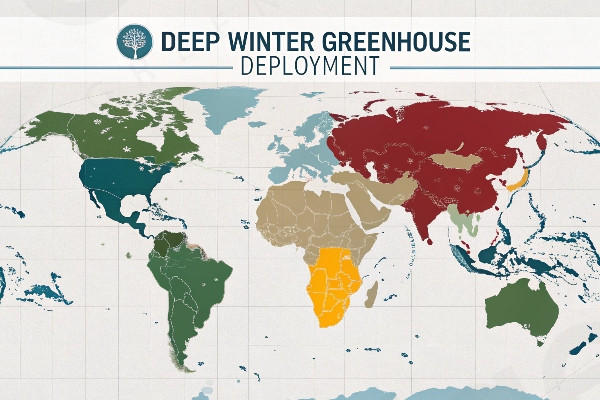
The latitude range between 35-55 degrees north provides optimal conditions for deep winter greenhouse operations. This zone receives sufficient winter sunlight for passive solar heating while experiencing cold enough temperatures to justify the specialized construction costs. Our installations in Montana, Minnesota, and similar climates consistently outperform those in warmer southern regions.
Regional Adaptation Strategies
Northern European countries represent ideal markets for deep winter greenhouse technology due to their combination of cold winters, moderate summer temperatures, and strong agricultural economies. We have successfully implemented systems in Norway, Sweden, and northern Germany where the growing season extension provides substantial economic benefits for commercial operations.
Central Asian regions present unique opportunities for deep winter greenhouse deployment, particularly in Kazakhstan, Uzbekistan, and northern China. These areas experience severe winters with abundant sunshine, creating perfect conditions for passive solar heating systems. The extreme temperature swings in these regions make thermal mass storage especially valuable for maintaining stable growing conditions.
High-altitude locations benefit significantly from deep winter greenhouse technology due to their intense solar radiation and cold nighttime temperatures. Mountain regions in Colorado, Montana, and similar areas can achieve year-round production of high-value crops that command premium market prices during winter months.
Crop selection focuses on plants that thrive in cooler temperatures and don’t require extensive heating systems. Leafy greens like spinach, kale, and lettuce perform exceptionally well in deep winter conditions. Root vegetables including carrots, radishes, and turnips tolerate the temperature fluctuations common in passive solar systems. Herbs such as cilantro, parsley, and chives provide high-value crops that can generate significant income from small growing areas.
The microclimate within the greenhouse allows for succession planting throughout the winter months, maintaining continuous harvests even when outdoor temperatures remain below freezing for extended periods. This capability transforms the economics of winter growing from a seasonal challenge into a year-round opportunity.
Conclusion
Deep winter greenhouses combine smart design with natural energy to create productive growing spaces year-round, turning harsh climates into profitable opportunities.

